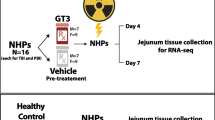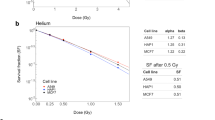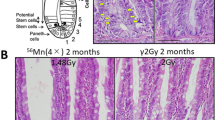Abstract
Energetic protons are the most abundant particle type in space and can pose serious health risks to astronauts during long-duration missions. The health effects of proton exposure are also a concern for cancer patients undergoing radiation treatment with accelerated protons. To investigate the damage induced by energetic protons in vivo to radiosensitive organs, 6-week-old BALB/c male mice were subjected to 250 MeV proton radiation at whole-body doses of 0.1, 1, and 2 Gy. The gastrointestinal (GI) tract of each exposed animal was dissected 4 h post-irradiation, and the isolated small intestinal tissue was analyzed for histopathological and gene expression changes. Histopathologic observation of the tissue using standard hematoxylin and eosin (H&E) staining methods to screen for morphologic changes showed a marked increase in apoptotic lesions for even the lowest dose of 0.1 Gy, similar to X- or γ rays. The percentage of apoptotic cells increased dose-dependently, but the dose response appeared supralinear, indicating hypersensitivity at low doses. A significant decrease in surviving crypts and mucosal surface area, as well as in cell proliferation, was also observed in irradiated mice. Gene expression analysis of 84 genes involved in the apoptotic process showed that most of the genes affected by protons were common between the low (0.1 Gy) and high (1 and 2 Gy) doses. However, the genes that were distinctively responsive to the low or high doses suggest that high doses of protons may cause apoptosis in the small intestine by direct damage to the DNA, whereas low doses of protons may trigger apoptosis through a different stress response mechanism.










Similar content being viewed by others
References
Hendry JH, West CM (1997) Apoptosis and mitotic cell death: their relative contributions to normal-tissue and tumour radiation response. Int J Radiat Biol 71:709–719
Meyn RE, Milas L, Ang KK (2009) The role of apoptosis in radiation oncology. Int J Radiat Biol 85:107–115. https://doi.org/10.1080/09553000802662595
Cucinotta FA, Durante M (2006) Cancer risk from exposure to galactic cosmic rays: implications for space exploration by human beings. Lancet Oncol 7:431–435. https://doi.org/10.1016/S1470-2045(06)70695-7
Donnelly EH, Nemhauser JB, Smith JM, Kazzi ZN, Farfán EB, Chang AS, Naeem SF (2010) Acute radiation syndrome: assessment and management. South Med J 103:541–546
Dorr H, Meineke V (2011) Acute radiation syndrome caused by accidental radiation exposure—therapeutic principles. BMC Med 9:126. https://doi.org/10.1186/1741-7015-9-126
Moreno-Villanueva M, Wong M, Lu T, Zhang Y, Wu H (2017) Interplay of space radiation and microgravity in DNA damage and DNA damage response. NPJ Microgravity 3:14. https://doi.org/10.1038/s41526-017-0019-7
Merchant TE (2009) Proton beam therapy in pediatric oncology. Cancer J 15:298–305. https://doi.org/10.1097/PPO.0b013e3181b6d4b7
Schulz-Ertner D (2009) The clinical experience with particle therapy in adults. Cancer J 15:306–311. https://doi.org/10.1097/PPO.0b013e3181b01922
Terasawa T, Dvorak T, Ip S, Raman G, Lau J, Trikalinos TA (2009) Systematic review: charged-particle radiation therapy for cancer. Ann Intern Med 151:556–565
Tommasino F, Durante M (2015) Proton radiobiology. Cancers (Basel) 7:353–381. https://doi.org/10.3390/cancers7010353
Weber U, Kraft G (2009) Comparison of carbon ions versus protons. Cancer J 15:325–332. https://doi.org/10.1097/PPO.0b013e3181b01935
Potten C (2002) Apoptosis induced in small intestinal crypts. Int Congr Ser 1236:407–413
Schuller BW, Binns PJ, Riley KJ, Ma L, Hawthorne MF, Coderre JA (2006) Selective irradiation of the vascular endothelium has no effect on the survival of murine intestinal crypt stem cells. Proc Natl Acad Sci USA 103:3787–3792. https://doi.org/10.1073/pnas.0600133103
Vereecke L, Beyaert R, van Loo G (2011) Enterocyte death and intestinal barrier maintenance in homeostasis and disease. Trends Mol Med 17:584–593. https://doi.org/10.1016/j.molmed.2011.05.011
Withers HR, Elkind MM (1970) Microcolony survival assay for cells of mouse intestinal mucosa exposed to radiation. Int J Radiat Biol Relat Stud Phys Chem Med 17:261–267
Potten CS (1977) Extreme sensitivity of some intestinal crypt cells to X and gamma irradiation. Nature 269:518–521
Miyoshi-Imamura T, Kakinuma S, Kaminishi M, Okamoto M, Takabatake T, Nishimura Y, Imaoka T, Nishimura M, Murakami-Murofushi K, Shimada Y (2010) Unique characteristics of radiation-induced apoptosis in the postnatally developing small intestine and colon of mice. Radiat Res 173:310–318. https://doi.org/10.1667/RR1905.1
Merritt AJ, Allen TD, Potten CS, Hickman JA (1997) Apoptosis in small intestinal epithelial from p53-null mice: evidence for a delayed, p53-independent G2/M-associated cell death after gamma-irradiation. Oncogene 14:2759–2766. https://doi.org/10.1038/sj.onc.1201126
Potten CS (2004) Radiation, the ideal cytotoxic agent for studying the cell biology of tissues such as the small intestine. Radiat Res 161:123–136
Hornsey S (1973) The effectiveness of fast neutrons compared with low LET radiation on cell survival measured in the mouse jejunum. Radiat Res 55:58–68
Finnberg N, Wambi C, Ware JH, Kennedy AR, El-Deiry WS (2008) Gamma-radiation (GR) triggers a unique gene expression profile associated with cell death compared to proton radiation (PR) in mice in vivo. Cancer Biol Ther 7:2023–2033
Potten CS (1991) Regeneration in epithelial proliferative units as exemplified by small intestinal crypts. Ciba Found Symp 160:54–71 discussion 71–6
Morris GM (1996) Review article: effects of radiation on the cell proliferation kinetics of epithelial tissues–therapeutic implications. Br J Radiol 69:795–803. https://doi.org/10.1259/0007-1285-69-825-795
Merritt AJ, Potten CS, Kemp CJ, Hickman JA, Balmain A, Lane DP, Hall PA (1994) The role of p53 in spontaneous and radiation-induced apoptosis in the gastrointestinal tract of normal and p53-deficient mice. Cancer Res 54:614–617
Komarova EA, Christov K, Faerman AI, Gudkov AV (2000) Different impact of p53 and p21 on the radiation response of mouse tissues. Oncogene 19:3791–3798. https://doi.org/10.1038/sj.onc.1203717
Inagaki-Ohara K, Yada S, Takamura N, Reaves M, Yu X, Liu E, Rooney I, Nicholas S, Castro A, Ware CF, Green DR, Lin T (2001) p53-dependent radiation-induced crypt intestinal epithelial cells apoptosis is mediated in part through TNF-TNFR1 system. Oncogene 20:812–818. https://doi.org/10.1038/sj.onc.1204172
Ijiri K (1989) Cell death (apoptosis) in mouse intestine after continuous irradiation with gamma rays and with beta rays from tritiated water. Radiat Res 118:180–191
Kerr JF, Wyllie AH, Currie AR (1972) Apoptosis: a basic biological phenomenon with wide-ranging implications in tissue kinetics. Br J Cancer 26:239–257
Wyllie AH (1997) Apoptosis: an overview. Br Med Bull 53:451–465
Ijiri K, Potten CS (1983) Response of intestinal cells of differing topographical and hierarchical status to ten cytotoxic drugs and five sources of radiation. Br J Cancer 47:175–185
Rasband WS (1997–2011) ImageJ. US National Institutes of Health, Bethesda
Casteleyn C, Van den Broeck W, Simoens P (2007) Histological characteristics and stereological volume assessment of the ovine tonsils. Vet Immunol Immunopathol 120:124–135. https://doi.org/10.1016/j.vetimm.2007.07.010
Casteleyn C, Rekecki A, Van der Aa A, Simoens P, Van den Broeck W (2010) Surface area assessment of the murine intestinal tract as a prerequisite for oral dose translation from mouse to man. Lab Anim 44:176–183. https://doi.org/10.1258/la.2009.009112
Lu T, Zhang Y, Kidane Y, Feiveson A, Stodieck L, Karouia F, Ramesh G, Rohde L, Wu H (2017) Cellular responses and gene expression profile changes due to bleomycin-induced DNA damage in human fibroblasts in space. PLoS ONE 12:e0170358. https://doi.org/10.1371/journal.pone.0170358
Baluchamy S, Zhang Y, Ravichandran P, Ramesh V, Sodipe A, Hall JC, Jejelowo O, Gridley DS, Wu H, Ramesh GT (2010) Differential oxidative stress gene expression profile in mouse brain after proton exposure. In Vitro Cell Dev Biol Anim 46:718–725. https://doi.org/10.1007/s11626-010-9330-2
Baluchamy S, Zhang Y, Ravichandran P, Ramesh V, Sodipe A, Hall JC, Jejelowo O, Gridley DS, Wu H, Ramesh GT (2010) Expression profile of DNA damage signaling genes in 2 Gy proton exposed mouse brain. Mol Cell Biochem 341:207–215. https://doi.org/10.1007/s11010-010-0451-4
Baluchamy S, Ravichandran P, Periyakaruppan A, Ramesh V, Hall JC, Zhang Y, Jejelowo O, Gridley DS, Wu H, Ramesh GT (2010) Induction of cell death through alteration of oxidants and antioxidants in lung epithelial cells exposed to high energy protons. J Biol Chem 285:24769–24774
Tariq MA, Soedipe A, Ramesh G, Wu H, Zhang Y, Shishodia S, Pourmand N, Jejelowo O (2011) The effect of acute dose charge particle radiation on expression of DNA repair genes in mice. Mol Cell Biochem 349:213–218. https://doi.org/10.1007/s11010-010-0641-0
Potten CS, Booth C (1997) The role of radiation-induced and spontaneous apoptosis in the homeostasis of the gastrointestinal epithelium: a brief review. Comp Biochem Physiol B: Biochem Mol Biol 118:473–478
Jee YH, Jeong WI, Kim TH, Hwang IS, Ahn MJ, Joo HG, Hong SH, Jeong KS (2005) p53 and cell-cycle-regulated protein expression in small intestinal cells after fast-neutron irradiation in mice. Mol Cell Biochem 270:21–28
Booth D, Haley JD, Bruskin AM, Potten CS (2000) Transforming growth factor-B3 protects murine small intestinal crypt stem cells and animal survival after irradiation, possibly by reducing stem-cell cycling. Int J Cancer 86:53–59
Cameron S, Schwartz A, Sultan S, Schaefer IM, Hermann R, Rave-Frank M, Hess CF, Christiansen H, Ramadori G (2012) Radiation-induced damage in different segments of the rat intestine after external beam irradiation of the liver. Exp Mol Pathol 92:243–258. https://doi.org/10.1016/j.yexmp.2011.11.007
Zhang Y, Moreno-Villanueva M, Krieger S, Ramesh GT, Neelam S, Wu H (2017) Transcriptomics, NF-kappaB pathway, and their potential spaceflight-related health consequences. Int J Mol Sci. https://doi.org/10.3390/ijms18061166
Czabotar PE, Lessene G, Strasser A, Adams JM (2014) Control of apoptosis by the BCL-2 protein family: implications for physiology and therapy. Nat Rev Mol Cell Biol 15:49–63. https://doi.org/10.1038/nrm3722
Fulda S, Debatin KM (2006) Extrinsic versus intrinsic apoptosis pathways in anticancer chemotherapy. Oncogene 25:4798–4811. https://doi.org/10.1038/sj.onc.1209608
Guamán Ortiz LM (2012) Chronicles of a Silent Death: apoptosis. Research in Cell Biology 1:1–7
Deveraux QL, Takahashi R, Salvesen GS, Reed JC (1997) X-linked IAP is a direct inhibitor of cell-death proteases. Nature 388:300–304. https://doi.org/10.1038/40901
Sun M, Meares G, Song L, Jope RS (2009) XIAP associates with GSK3 and inhibits the promotion of intrinsic apoptotic signaling by GSK3. Cell Signal 21:1857–1865. https://doi.org/10.1016/j.cellsig.2009.08.002
Irmler M, Steiner V, Ruegg C, Wajant H, Tschopp J (2000) Caspase-induced inactivation of the anti-apoptotic TRAF1 during Fas ligand-mediated apoptosis. FEBS Lett 468:129–133
Jurk D, Wilson C, Passos JF, Oakley F, Correia-Melo C, Greaves L, Saretzki G, Fox C, Lawless C, Anderson R, Hewitt G, Pender SL, Fullard N, Nelson G, Mann J, van de Sluis B, Mann DA, von Zglinicki T (2014) Chronic inflammation induces telomere dysfunction and accelerates ageing in mice. Nat Commun 2:4172. https://doi.org/10.1038/ncomms5172
Acknowledgements
The first author (AP) wishes to dedicate this work to the memory of Michael Gilles Purgason. This work was supported by the US Department of Energy Low Dose Radiation Program and the NASA Human Research Program. AP was supported in part by the NASA Graduate Student Research Program. MMV was supported by German Research Foundation (DFG).
Author information
Authors and Affiliations
Corresponding author
Ethics declarations
Conflict of interest
The authors declare no conflict of interest.
Rights and permissions
About this article
Cite this article
Purgason, A., Zhang, Y., Hamilton, S.R. et al. Apoptosis and expression of apoptosis-related genes in mouse intestinal tissue after whole-body proton exposure. Mol Cell Biochem 442, 155–168 (2018). https://doi.org/10.1007/s11010-017-3200-0
Received:
Accepted:
Published:
Issue Date:
DOI: https://doi.org/10.1007/s11010-017-3200-0




